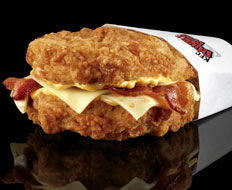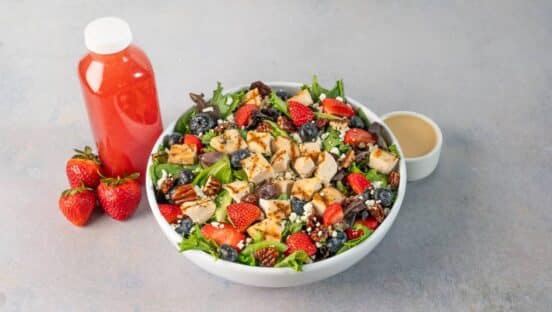Perhaps the biggest splash so far this year in the quick-service sector came in April when KFC’s Double Down, a breadless “sandwich” that features melted cheese, bacon, and sauce between two chicken filets, made its national debut.
The advent of a sandwich that bucked sliced bread—a seemingly indispensible ingredient to one of America’s beloved food items—in favor of chicken (fried or grilled) as the item’s carrier caught a lot of people’s attention. Before the end of last summer’s test run in Omaha, Nebraska, and Providence, Rhode Island, it had become a hot topic in the blogosphere.
“It became kind of this Internet legend,” says KFC spokesman Rick Maynard. “People started posting photos online, and people starting inquiring whether the sandwich was real, or whether it existed. The thing actually took on national and even international momentum while it was in test market.”
The momentum carried over into the Double Down’s first month on KFC’s national menu, during which 10 million customers showed up to give it a try. Despite the impressive consumer demand, the Double Down received plenty of groans from food critics for being greasy and alarmingly salty.
“The Double Down did go all the way down, though not an easy task, but it required lots of water,” wrote Gerrick D. Kennedy, an L.A. Times blogger. “Sadly, within 10 minutes the sandwich caused some physical distress.”
As the Double Down made headlines around the world, concerned health experts chimed in. The British Daily Mail quoted Kelly Brownell, director of Yale University's Rudd Centre for Food Policy and Obesity, describing the sandwich as a “salt bomb.” The fried Double Down has 1,380 milligrams of sodium, more than half of the Institute of Medicine’s daily recommended intake. Surprisingly, the grilled version has more sodium: 1,430 milligrams.
On the heels of the Double Down came two new sandwiches that caused a stir. In June, Massachusetts-based Friendly’s introduced its Ultimate Grilled Cheese Burgermelt. A burger patty between two grilled cheese sandwiches, it clocks in at 1,500 calories, 97 grams of fat, and 2,090 milligrams of sodium.
Then, in July, CKE Restaurants began testing a foot-long cheeseburger in select Carl’s Jr. and Hardee’s locations. CKE declined to comment on the sandwich or share its nutritional information since it is still being tested. But with a Carl’s Jr. Original Six Dollar Burger registering at 890 calories, 54 grams of fat, and 2,040 milligrams of sodium, it’s fair to predict the foot-long cheeseburger will scare its fair share of health gurus.
The Double Down, the Ultimate Grilled Cheese Burgermelt, and the foot-long burger don’t necessarily break any records for calorie counts or any other category of nutrition. But the fact that they are so overtly unhealthy seems to be why they have received so much buzz and, at the same time, criticism.
In recent years, more quick serves have begun offering salads, wraps, and other items tailored to the health-conscious consumer. Last April, KFC introduced grilled-chicken menu items for the first time in its long, deep-fried history.
But Michael Jacobson, executive director of the Center for Science in the Public Interest, says the trio of sandwiches calls into question the strength of the sector’s commitment to serving healthy fare.
“Quick serves love bragging about the occasional ‘healthy’ item they add to their menus, but are very quiet about the outrageously high-calorie, saturated-fat, or sodium levels of some of their new offerings,” Jacobson wrote in an e-mail to QSR.
“Adding new products that contain one or two days' worth of sodium or saturated fat certainly undermines the public's health. … Such products might sell well to college-age guys, but they are gradually clogging their arteries and boosting their blood pressure.”
In an e-mail, Andre Fuehr, vice president of R&D for Friendly’s, said the company does not tailor its menu items to any particular market.
“That’s not how culinary works,” Fuehr wrote. “We look at items from a much simpler point of view: Does it taste great? Is it something our guests (all, not subsets) would like to order?”
Fuehr stood by the Ultimate Grilled Cheese Burgermelt, saying “Supermelts” are part of Friendly’s heritage.
“The fact this item has garnered headlines was unexpected and a total surprise,” he wrote. “We might be the first large chain of restaurants to introduce this item, but it has been on independent restaurant menus for years.”
If any publicity is good publicity, KFC, Friendly’s, and CKE have scored three of the biggest marketing coups so far this year. Restaurantmarketing.com owner Joel Cohen says the restaurants have targeted a large and lucrative segment of consumers that aren’t too worried about the warnings of health experts and food critics.
“They appeal to the insatiable hunger and desire for fast food,” Cohen says. “There’s an audience out there that is not concerned about the ingredients, and they’ll eat it.”











